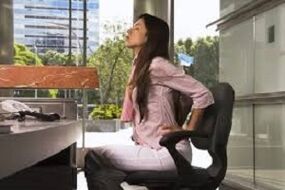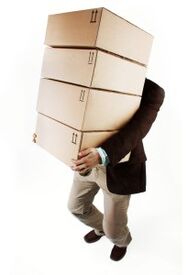Osteochondrosis of the lumbar spine is a common pathological disease of the spine. There is a degeneration of cartilage tissue into bone, degradation of the intervertebral discs. The ossified annulus fibrosus is reduced and cannot cope with the function of devaluing the vertebral sections, it creates pressure on the nerve endings of the spinal cord, which causes pain in the lower back.
Stages of development of osteochondrosis of the lumbar spine
- The primary sign of the development of osteochondrosis is an uncomfortable feeling in the lower back.
- The second stage is characterized by the protrusion of the intervertebral discs: the destruction of the fibrous ring, the intervertebral gaps decrease, pain occurs when the nerve endings are pinched.
- In the third stage, the spine is deformed, the annulus fibrosus is destroyed by the action of the displaced disc, and the contents leak out. An intervertebral hernia forms.
- The fourth stage is acute osteochondrosis of the lumbar spine. It is considered severe, back pain interferes with movement.
symptoms of the disease

The first call signaling the development of osteochondrosis of the lumbar spine is periodic discomfort, back pain. Depending on the inclination of the violation, there are pains with lancinating, aching pains, pains radiating to the leg, buttocks, thighs.
Characterized by discomfort after a long stay in a horizontal position. A person cannot relax for some time after sleeping. In the lumbar region, pains of a different nature appear: dull, aching, insensitivity of soft tissues due to injury to nerve endings. Running with osteochondrosis of the lumbar spine causes pain with possible leg drag.
With prolonged pinching of the nerve roots, lumbosacral osteochondrosis often occurs, disruption of the work of internal organs, insensitivity of the genital organs and dysfunction of the genitourinary system. A change in the position of the intervertebral discs leads to a partial injury to the blood vessels, causing vascular dystonia, in which blood does not flow to the lower body in sufficient quantities and does not circulate normally. Internal organs suffer, partial numbness of the limbs, convulsions are observed.
With sudden movements, coughing, back pain are observed - a sharp, quickly disappearing pain, comparable to an electric shock. With the development of diseases of the lumbar region, the reflex functions of the tendons of the lower extremities weaken.
If you suspect a disease, the occurrence of repeated pain, it is recommended to consult a doctor for advice and diagnosis. It is dangerous to let go, the disease is progressing. Loss of time due to negligent behavior towards health is at the expense of the patient.
causes of the disease
A reliable cause of osteochondrosis of the lumbar spine is not known. The disease is formed by a combination of adverse factors affecting changes in bone and cartilage tissue. Internal factors affecting premature aging of bone tissue:
- Disturbed functioning of the endocrine system;
- autoimmune diseases;
- Improper metabolism;
- microtrauma of the spine;
- hormonal disorders;
- dehydration of the body;
- inheritance.
External factors that influence the development of the disease should be called the influence of the environment, physical activity and habits. Factors:

- Periodic overload of the back muscles;
- weightlifting;
- muscle hypotonia;
- overload of the spine;
- wrong posture;
- Poor diet;
- Bad habits;
- Emphasize.
Osteochondrosis of the lumbar spine is common in people who perform a standing type of work: salespeople, teachers, security guards.
Occupations with high performance are at risk: athletes, builders, loaders. A common form is sciatica, prolapse, herniated disc. Sedentary work of office workers, civil servants, programmers, drivers leads to hypodynamia of the back muscles. The work of maintaining an upright position falls on the spine, there are changes in posture, pinching of nerve tissue, blood vessels and numbness in the extremities.
Treatment of osteochondrosis of the lumbar spine
With acute pain in the lumbar region, it is recommended to contact a medical institution for a full examination to determine the cause of the sensations that have arisen. It may be appendicitis, biliary colic, or another disease with primary symptoms resembling lumbar osteochondrosis.
Depending on the degree of progression of the disease, syndrome, the doctor prescribes a treatment consisting of drug treatment, physical strengthening exercises, spa treatments and diet. In the last stages of spinal modification, surgical intervention is justified. Drug treatment includes the use of ointments, injections, patches and tablets. Dosage, course of treatment depends individually on the patient's condition, neglect of the disease.
- The initial task in the treatment of osteochondrosis is to relieve acute pain, reduce tension and muscle spasms. Apply:
- Nonsteroidal anti-inflammatory drugs in the form of injections, tablets. After ingestion, the pain subsides, the inflammation of the tissues decreases.
- Drugs that relieve symptoms are analgesics.
- Antispasmodic drugs work for a short time, relaxing the muscle fibers located around the focus of pain.
- Drugs that improve microcirculation, increase blood flow to the organs, providing them with oxygen and essential substances.
- Diuretics to relieve swelling, pressure on the spine.
- To restore cartilage tissue, his diet uses two branches of drugs:
- Chondroprotectors - ointments, tablets, injections containing enzymes that promote the regeneration of cartilage tissue. Apply a long course of up to six months with breaks of 2-3 months.
- The vitamin complex accelerates the restoration of cartilage tissue, supplies the intervertebral discs with essential substances.
- The main drug treatment is prescribed after the patient has undergone an MRI to determine the cause of the disease.
The appointments listed are short-term measures, they do not affect the course of the disease, they alleviate the patient's condition. To get rid of the disease, painkillers, symptomatic drugs alone are indispensable. We need an intelligent, holistic approach.
For recovery, it is recommended to use physiotherapeutic procedures that improve blood circulation and stimulate the muscles of the lumbar region. Effective methods are electrophoresis, magnetic field, ultrasonic waves, laser treatment.
Among the physiotherapeutic exercises, yoga is in demand for osteochondrosis of the lumbar spine. Simple postures, stretches release tension from the muscles, strengthen them. Independent sports without proper training can seriously harm instructor insurance.
How to protect yourself from osteochondrosis?
Prevention of osteochondrosis of the lumbar spine consists in regular training of the back muscles, an active lifestyle and a balanced diet. The load on the lumbar spine must be even. Using a hard mattress while sleeping reduces the chances of getting sick. Regular, annual visits to the doctor from the age of 40 enable an early diagnosis and show a predisposition.

















































